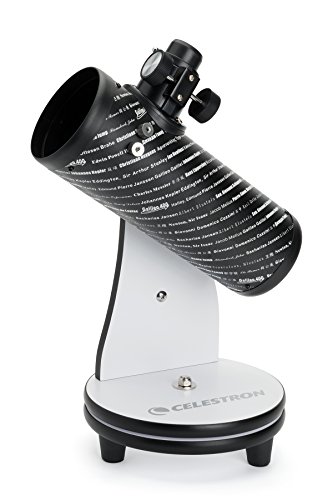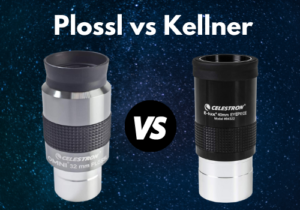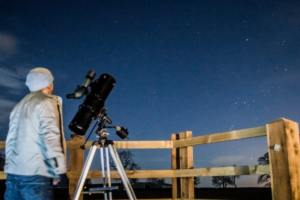What Is A Reflector Telescope? How Is It Different From Other Telescopes
Disclosure: This post contains affiliate links and I may earn a small commission (at no extra cost to you) if you click through and make a purchase. Thanks in advance – I really appreciate it!
The first reflecting telescope was built way back in 1668 by none other than Isaac Newton. We still use a similar version of a reflector telescope today because they’re very cheap to build and produce. Because of this, these telescopes heavily populate the entry-level market. I had my first reflector at the age of 10, it was a 4” telescope from Celestron.
Key Takeaways:
What exactly is a reflector telescope?
A reflector telescope uses a concave primary mirror which is fixed at the back of the optical tube. The primary mirror reflects the light onto another flat secondary mirror which is precisely angled to deflect the image at a 90-degree angle to be viewed through an eyepiece.
If you want to learn more about Reflector telescopes and how do they compare with Refractors and Catadioptric telescopes, then read on!
Related: Best Telescope For Home Use; Reviews
How Do The Reflector Telescopes Work
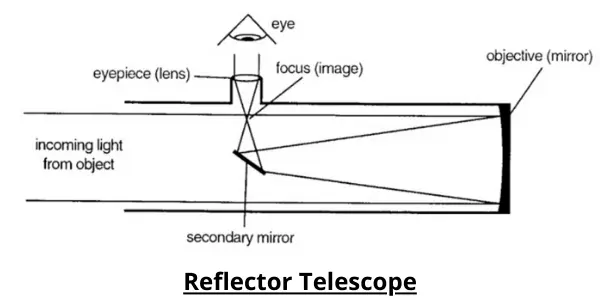
The reflector telescopes are the most widespread telescopes in the market because of their easy building process and their low cost.
The light coming from a star or any celestial object enters the optical tube and falls onto a concave primary mirror, located at the back of the optical tube.
The primary mirror gathers the light and focuses it towards a flat secondary mirror that is set partway up the tube.
This secondary mirror is set at a 45-degree angle so the light can be directed to the focuser on the side of the tube. The focuser holds the eyepiece. There is no diagonal as the secondary mirror serves this purpose.
The front-placed eyepiece is one of the defining characteristics of a reflector telescope and makes it easy to tell them apart from other types of telescopes at a glance.
Some reflecting telescopes use a convex secondary mirror and a perforated primary or base mirror such as the Cassegrain reflectors. These parabolic mirrors can reflect and concentrate all incident rays to a single focal point.
Another type of mirror used in reflectors is spherical mirrors. These mirrors are easy to produce but have varying focal lengths, which result in a fuzzy image.
The reflector telescope produces an image that is rotated 180 degrees, or upside down (though not flipped left-right).
This is not a big issue for astronomical purposes, as there is no up or down in space. However, this does render this type of scope impractical for terrestrial observations.
Because parabolic mirrors have fewer surfaces and are thus easier to make than lenses, combined with the cheapness of the relatively common plate or borosilicate glass used in most astronomical mirrors, reflectors can be made for very low costs and at very large sizes.
An 8” reflector can be obtained for a similar cost to a 4” refractor but has double the resolution and quadruple the light gathering ability – while sporting zero chromatic aberration to boot.
Related: Best Starter Telescope; Reviews
Reflector telescopes are great when you need the maximum amount of light in your image. If you’re not able to get enough light from the celestial bodies you’re viewing for a clear image, the large mirrors of a reflector telescope might reflect enough light to allow for improved viewing.
Although the biggest asset of a reflector is its primary mirror’s very large size. The bigger the mirror is, the brighter the objects appear in the eyepiece. However, a big mirror could quickly emphasize the optical aberrations of the telescope, known as the Coma.
Related: Best Small Telescope; Reviews
Coma
Coma is an aberration that occurs in reflector telescopes, especially in lower focal ratio designs.
Coma manifests itself in the appearance of ‘comet-shaped stars with their brightest portion pointing towards the center of the field of view.
In scopes that have a focal ratio of F6 and higher, this is significantly reduced. Below F5 an additional lens is often added to the light path which is called a coma corrector to control or eliminate coma.
Related: Best Telescope To See Saturn & Its Rings; Reviews
Magnification
In a reflector telescope, magnification is taken care of by the eyepiece. This enables you to purchase additional eyepieces with varying degrees of magnification. Then, you can easily and quickly swap them out to change your view.
Many reflector telescopes will include one or more eyepieces, generally offering magnification levels between 40x and 200x.
Focal Length
The focal length is essentially the distance (in millimeters) that light travels inside the telescope from its entry point (the aperture) to the exit point (the focuser where you place your eyepiece).
In a reflecting telescope, the focal length starts at the aperture (primary mirror) and ends at the focuser where the light rays come together.
In the case of reflectors, the optical tube is longer than the focal length by a fair amount.
Related: Best Telescope For Beginners; Reviews
True Field of View
The true field of view (TFOV) is how much of the sky you can see when looking through your telescope with any particular eyepiece in place.
You can calculate the true field of view of a telescope + eyepiece combination using the following formula:
True field of view = Apparent field of view / magnification
Where magnification is calculated by dividing your telescope’s focal length by the focal length of your eyepiece.
Related: Best Telescope Under $200; Reviews
Good Reflector Telescopes For Beginners
Celestron 21024 FirstScope
- High quality Dobsonian style stand with a 76 mm reflector optical tube make FirstScope an ideal entry level astronomical telescope
- Portable and lighweight table-top design makes it easy to store, transport and setup your FirstScope Telescope
Prices pulled from the Amazon Product Advertising API on:
Product prices and availability are accurate as of the date/time indicated and are subject to change. Any price and availability information displayed on [relevant Amazon Site(s), as applicable] at the time of purchase will apply to the purchase of this product.
The Celestron 21024 FirstScope Telescope offers excellent potential as a first telescope for beginner astronomers eager to learn more about reflector-style scopes and their optical capabilities. Although priced towards the lower end, the Celestron 21024 easily stands up against other competitors. Aesthetically pleasing, this particular model features a chic and modern look. The compact design, lightweight frame, and portability make the Celestron 21024 easy to grab on the way out.
Click here to check the price on Amazon.
Orion 10015 StarBlast 4.5 Astro Reflector
- A great compact grab-and-go telescope designed for entry-level and intermediate astronomy enthusiasts; Focal length: 450mm
- Substantial 4.5 inch aperture and fast f/4 focal ratio provides bright, detailed views of solar system targets like the Moon and planets, as well as wide-field celestial objects like nebulas and star clusters
- Ships pre-assembled so you can go from the box to your backyard in minutes. Glass material : Low thermal expansion borosilicate glass
Prices pulled from the Amazon Product Advertising API on:
Product prices and availability are accurate as of the date/time indicated and are subject to change. Any price and availability information displayed on [relevant Amazon Site(s), as applicable] at the time of purchase will apply to the purchase of this product.
Orion StarBlast 4.5 Astro Reflector is a great compact grab-and-go telescope designed for entry-level and intermediate astronomy enthusiasts. A substantial 4.5″ aperture and fast f/4 focal ratio provides bright, detailed views of solar system targets like the Moon and planets, as well as wide-field celestial objects like nebulas and star clusters.
Ships pre-assembled so you can go from the box to your backyard in minutes.
The stable tabletop base provides smooth altazimuth motion for easy manual tracking of celestial objects.
Click here to check the price on Amazon.
Celestron – PowerSeeker 127EQ
- Perfect entry-level telescope: The Celestron PowerSeeker 127EQ is an easy-to-use and powerful telescope. The PowerSeeker series is designed to give the new telescope user the perfect combination of quality, value, features, and power
- Manual German equatorial mount: Navigate the sky with our Newtonian Reflector telescope. It features a German Equatorial mount with a slow-motion altitude rod for smooth and accurate pointing.
Prices pulled from the Amazon Product Advertising API on:
Product prices and availability are accurate as of the date/time indicated and are subject to change. Any price and availability information displayed on [relevant Amazon Site(s), as applicable] at the time of purchase will apply to the purchase of this product.
The Celestron PowerSeeker 127EQ Newtonian Telescope is designed to give the first-time buyer the perfect combination of quality, value, features, and power. Offering exceptional value, the Celestron PowerSeeker 127EQ features portable yet powerful designs with ample optical performance to excite any newcomer to the world of amateur astronomy. Celestron 127EQ comes with all coated glass optical components for enhanced image brightness and clarity.
Click here to check the price on Amazon.
Celestron – AstroMaster 130EQ
- Powerful reflector telescope: The Celestron AstroMaster 130EQ telescope is a powerful reflector telescope for astronomy beginners. It features fully-coated glass optics, a sturdy and lightweight frame, 2 eyepieces, a StarPointer red dot finderscope and an adjustable tripod.
- High-quality 130mm optics: The heart of the system is a 130mm glass optic objective lens. The AstroMaster mount features 2 slow-motion control knobs that allow you to make precision adjustments.
Prices pulled from the Amazon Product Advertising API on:
Product prices and availability are accurate as of the date/time indicated and are subject to change. Any price and availability information displayed on [relevant Amazon Site(s), as applicable] at the time of purchase will apply to the purchase of this product.
Celestron AstroMaster 130 EQ Equatorial Reflector Telescope is a dual-purpose telescope that is great for both terrestrial and celestial viewing. The Celestron Astro Master 130 EQ produces bright and clear images of the Moon and planets through the telescope’s fully coated lens.
The Celestron Astro Master w/ Equatorial Mount has a large 130mm mirror, making it a great medium-sized telescope that will allow the user room to grow in astronomy.
This 130mm mirror is the largest mirror in the AstroMaster Series, and will easily provide enough light to see the moons of Jupiter, rings of Saturn, star clusters, and nebulae.
Click here to check the price on Amazon.
Advantages Of Reflector Telescope
Mirrors
Reflecting telescopes use mirrors and because mirrors have only one reflective surface, they are easier to construct than lenses.
No chromatic aberrations
Reflecting telescopes are not subject to chromatic aberration because the reflected light does not disperse according to the wavelength, and all the wavelengths will reflect off the mirror in the same way.
Ability to capture light
Because mirrors are easier to construct than lenses, they can be made larger and more durable. The larger the mirror, the more light can be directed to the eyepiece.
Cheaper to produce
Because reflecting telescopes use mirrors instead of lenses made from optical glass, they are less expensive to produce.
Lenses are used for smaller telescopes and particularly for observing a point on the Earth’s surface.
Reflecting telescopes of comparable size cost significantly less to produce. Once size nears 100mm, when compared to its refractor counterpart, a reflector is more cost-efficient because mirrors are cheaper to make than lenses.
Size & Portability
For reflecting telescopes, the optical tube is much smaller and more compact. This is because the focal point is located beyond the secondary mirror – which makes it possible for the telescope length to be about 1/2 the focal distance or even smaller. (For a classic Newtonian reflector, it’s about 1/2. For a compound telescope, it can be even smaller because the light is redirected multiple times.)
Their compact size makes them easy to transport, balance, and maneuver.
Best for Deep Sky Objects
If you are studying astronomy and want to see clear and large views for DSO’s or other celestial stuff, then a reflector telescope is ideal.
Reflectors are a great tool in observing celestial bodies near Earth but also excellent in viewing farther objects such as the moons of Saturn and Jupiter, distant galaxies, and nebulae.
Disadvantages Of Reflector Telescopes
Requires cleaning
The optical tube of a reflector telescope is wide open. This means that dust, dirt, and other contaminants can easily get inside, so you’ll have to continually clean the mirrors and the optical tube.
Requires regular collimation
Reflector telescopes use two mirrors and an eyepiece. But those mirrors need to be aligned with each other each time you use the telescope in a process called collimation. An improperly aligned telescope results in a blurry or marred image.
Coma
Reflectors do introduce an aberration called coma, especially in lower/faster focal ratio designs.
Coma results in stars that are near the outer edge of the field of view becoming blurry and appearing to have a comet-like tail or cross shape.
Reflector Telescopes Vs Refractor Telescopes
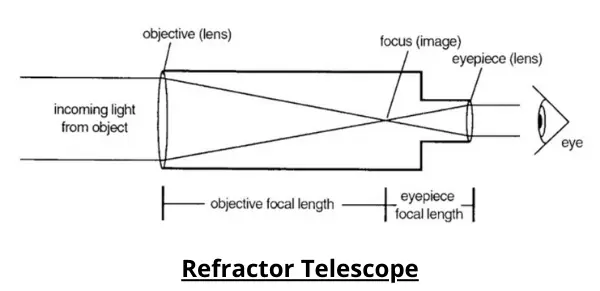
Where reflectors use mirrors, the refractor telescopes use 2 lenses to produce an image.
Refractor telescopes have a large lens on the very front. This lens is convex, taking in light and refracting or bending it into a smaller beam of light that gets sent back to another lens at the rear of the telescope.
This lens, also convex but facing the other direction, takes the smaller beam of light and magnifies it so that you can get a large, clear image.
The glass lens “refracts” (or bends) the light so that it reaches a focal point. The size of the lens (known as the telescope’s “objective”) determines the amount of light the telescope can collect. (This is also referred to as the telescope’s “aperture“.) The focal length of the telescope, divided by the focal length of the eyepiece, determines the amount of magnification. The focal length also determines the field of view. (A shorter focal length provides a wider field of view, measured in degrees.)
Advantages Of Refractor Telescopes
- Produces images with good contrast and sharpness.
- Refractors are easy to use and set up.
- They are lightweight and easy to transport.
- The closed optical tube of refractors protects the optics against humidity and dust.
- Refractors don’t need regular maintenance and cleaning because of their closed tube design.
Disadvantages Of Refractor Telescopes
- All refractor telescopes suffer from chromatic aberrations.
- Refractors are generally produced with smaller lenses which means they collect less light.
- Lenses are more expensive to produce as compared to mirrors. A good 4” refractor costs $400 or more. A 6” reflector can be bought for $300 and will beat the 4” refractor at everything.
Reflector Telescopes Vs Catadioptric Telescopes
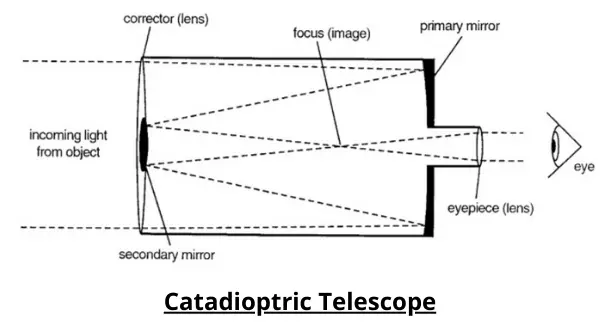
The catadioptric telescope is an optical telescope that uses a combination of specifically-shaped lenses and mirrors to form an image and transmit it to the eyepiece and, in turn, the observer.
Light enters through the end of the telescope through a correcting lens. The presence of this lens corrects the aberrations often encountered as a result of later steps of the process.
The light is then reflected off the primary mirror at the other end of the telescope.
The light then strikes the secondary mirror in the center of the correcting lens and it is then reflected back toward a hole in the primary mirror and into the eyepiece.
The four catadioptric telescope designs most commonly used by amateur astronomers are:
- Schmidt-Cassegrain
- Maksutov-Cassegrain
- Schmidt-Astrograph
- Schmidt-Newtonian
Advantages Of Catadioptric Telescopes
- Short length.
- Very practical handling.
- Portable.
- Viewing is always comfortable.
- The SC thread allows a wide range of accessories to be connected.
- Instruments with a fork mount can be set up extremely rapidly.
Disadvantages Of Catadioptric Telescopes
- More expensive than a Newtonian of comparable aperture.
- Larger secondary mirror than with a Newtonian telescope.
Written by:

Kavya Joshi
My love affair with space began in a field in India at the age of 7, when I looked up at the Milky Way for the first time. Ever since, I have been attempting to cram in every fact about the Universe, I can find into my head.
ABOUT US
We are a team of active amateur astronomers, here to help you with all your astronomy and science related needs – this is anything, from reviewing the latest telescopes to be released to talking about gravity and neurons. The Big Bang Optics was started because of our love for astronomy and to help others like us find the best telescope and accessories.
LEGAL DISCLAIMER
The Big Bang Optics is a participant in the Amazon Services LLC Associates Program, an affiliate advertising program designed to provide a means for sites to earn advertising fees by advertising and linking to Amazon.com. The Big Bang Optics also participates in affiliate programs with Clickbank and other sites. The Big Bang Optics is compensated for referring traffic and business to these companies.

